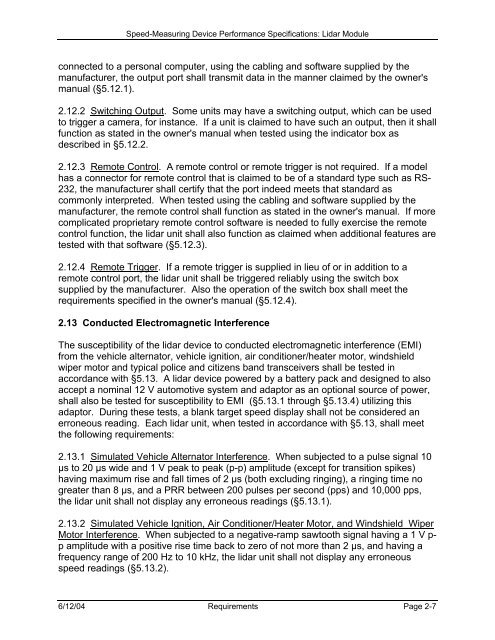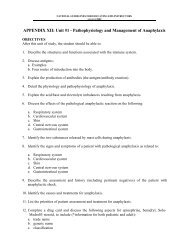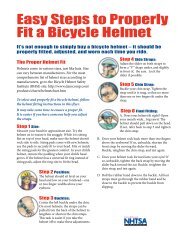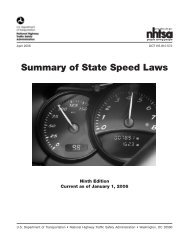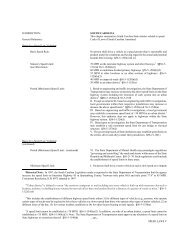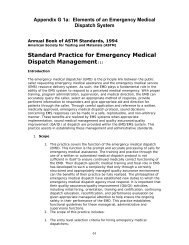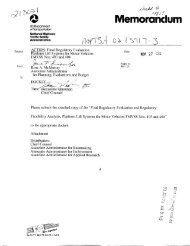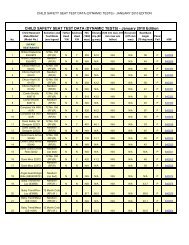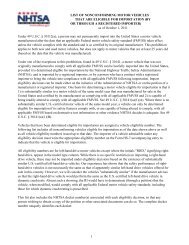Speed-Measuring Device Performance Specifications: Lidar Module
Speed-Measuring Device Performance Specifications: Lidar Module
Speed-Measuring Device Performance Specifications: Lidar Module
Create successful ePaper yourself
Turn your PDF publications into a flip-book with our unique Google optimized e-Paper software.
<strong>Speed</strong>-<strong>Measuring</strong> <strong>Device</strong> <strong>Performance</strong> <strong>Specifications</strong>: <strong>Lidar</strong> <strong>Module</strong><br />
connected to a personal computer, using the cabling and software supplied by the<br />
manufacturer, the output port shall transmit data in the manner claimed by the owner's<br />
manual (§5.12.1).<br />
2.12.2 Switching Output. Some units may have a switching output, which can be used<br />
to trigger a camera, for instance. If a unit is claimed to have such an output, then it shall<br />
function as stated in the owner's manual when tested using the indicator box as<br />
described in §5.12.2.<br />
2.12.3 Remote Control. A remote control or remote trigger is not required. If a model<br />
has a connector for remote control that is claimed to be of a standard type such as RS-<br />
232, the manufacturer shall certify that the port indeed meets that standard as<br />
commonly interpreted. When tested using the cabling and software supplied by the<br />
manufacturer, the remote control shall function as stated in the owner's manual. If more<br />
complicated proprietary remote control software is needed to fully exercise the remote<br />
control function, the lidar unit shall also function as claimed when additional features are<br />
tested with that software (§5.12.3).<br />
2.12.4 Remote Trigger. If a remote trigger is supplied in lieu of or in addition to a<br />
remote control port, the lidar unit shall be triggered reliably using the switch box<br />
supplied by the manufacturer. Also the operation of the switch box shall meet the<br />
requirements specified in the owner's manual (§5.12.4).<br />
2.13 Conducted Electromagnetic Interference<br />
The susceptibility of the lidar device to conducted electromagnetic interference (EMI)<br />
from the vehicle alternator, vehicle ignition, air conditioner/heater motor, windshield<br />
wiper motor and typical police and citizens band transceivers shall be tested in<br />
accordance with §5.13. A lidar device powered by a battery pack and designed to also<br />
accept a nominal 12 V automotive system and adaptor as an optional source of power,<br />
shall also be tested for susceptibility to EMI (§5.13.1 through §5.13.4) utilizing this<br />
adaptor. During these tests, a blank target speed display shall not be considered an<br />
erroneous reading. Each lidar unit, when tested in accordance with §5.13, shall meet<br />
the following requirements:<br />
2.13.1 Simulated Vehicle Alternator Interference. When subjected to a pulse signal 10<br />
µs to 20 µs wide and 1 V peak to peak (p-p) amplitude (except for transition spikes)<br />
having maximum rise and fall times of 2 µs (both excluding ringing), a ringing time no<br />
greater than 8 µs, and a PRR between 200 pulses per second (pps) and 10,000 pps,<br />
the lidar unit shall not display any erroneous readings (§5.13.1).<br />
2.13.2 Simulated Vehicle Ignition, Air Conditioner/Heater Motor, and Windshield Wiper<br />
Motor Interference. When subjected to a negative-ramp sawtooth signal having a 1 V pp<br />
amplitude with a positive rise time back to zero of not more than 2 µs, and having a<br />
frequency range of 200 Hz to 10 kHz, the lidar unit shall not display any erroneous<br />
speed readings (§5.13.2).<br />
6/12/04 Requirements Page 2-7


